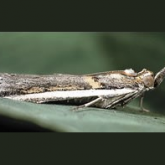Etiella

Etiella moth at rest
© J. Wessels, Queensland Government

Seed damage caused by etiella moth larvae
© J. Wessels, Queensland Government
A major but sporadic pest of a range of legume crops. In peanuts, damage is often associated with a higher incidence of aflatoxin.
Scientific name
Other names
- Lucerne seed web moth
Description
Adults:
- slender, 12mm long
- prominent 'snout' formed by mouthparts
- 20–22mm wingspan
- grey-brown with wings, folded back along the body when resting
- forewings have a distinctive light stripe along the leading edge and an orange band across the middle
- hindwings are pale grey.
Larvae change colour as they age:
- small larvae are cream or pale green, with no stripes and a dark head
- mid-sized larvae are pale green or cream, with pale brown or reddish stripes
- large larvae are green with pink or reddish stripes and a brown head
- pre-pupal larvae stage can be aqua blue or dark pink with no stripes.
Eggs are small (0.6mm diameter), cream and flattened.
May be confused with
- Moths may be confused with other non-pest Etiella spp. that feed on rattle pods.
- Webbing at the base of peanuts may be confused with that made by the (darker) larvae of Endotricha puncticostalis and Lecithocera sp. Both are common but not pests.
- Larval frass adhering to damaged mungbean seeds is frequently mistaken for bruchid eggs.
Distribution and habitat
Widespread across Australia.
Hosts
- Pest of soybean, mungbean, navy bean, azuki bean, lucerne.
- Important pest of peanuts (especially in drier areas) and specialist legumes (e.g. natto soybeans).
- Rattle pods are favoured weed hosts.
Damage
Seeds are usually only partially eaten, often with characteristic pin-hole damage. Damaged seed is difficult to grade and its unattractive appearance reduces seed quality.
In peanuts:
- damage is a major aflatoxin risk factor. The Aspergillus fungus gains entry to pods through larval exit holes. Etiella-damaged pods can have aflatoxin levels 100 times greater than undamaged pods
- infestations initiated close to harvest can result in larvae emerging after harvest as peanut pods dry in storage
- pod damage is most likely in drought years as soil moisture inhibits larvae moving in the soil. Cracks in dry soils also assist movement.
Life cycle
Eggs are laid on pods and flowers or under bracts and are very hard to detect.
Newly hatched larvae:
- in most legumes with above-ground pods, bore straight into pods leaving a near-invisible entry hole. Larvae develop (1 per pod) before escaping through a 2–3mm wide exit hole
- in peanuts, move down the plant and reach the below-ground pods within 24 hours of egg hatch.
The life cycle can be completed in 4 weeks at 30°C.
Monitoring and thresholds
Crops may be infested from flowering onwards but are at greatest risk during late podding. To get an indication of moth activity:
- use sweep nets, light traps or pheromone lures
- visually inspect pods for larvae.
Natural enemies
Some parasitoids and predatory bugs will attack etiella moth larvae but are unlikely to significantly impact large populations of this pest.
Control
- Select varieties by speed of maturity, and adjust planting times to avoid peak etiella moth activity.
- Very few pesticides are registered against this pest in Queensland.
- Pesticides are relatively ineffective once the larvae has entered the pod.
- Late irrigations reduce the risk in peanuts by wetting the surface soil.
Further information
- Lucerne seed web moth—Cesar PestNotes
- Registered chemicals database—Australian Pesticides and Veterinary Medicines Authority (APVMA)
- Pulse entomologist Hugh Brier discusses etiella (video series):